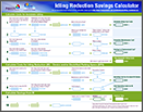Medium-Duty Vehicle Idle Reduction Strategies
How Much Can I Save?
Use the Idle Reduction Savings Worksheet to calculate your potential savings.
Typical medium-duty trucks include utility, courier, and package delivery trucks. Some utility trucks, such as bucket trucks, idle to provide power for the truck’s primary work function. Other trucks idle to provide heating, ventilation, and air conditioning (HVAC) for drivers waiting in queues to make pick-ups or deliveries or who are working in their vehicles. Educating fleets and drivers about the use of idle reduction technologies can help save fuel and reduce emissions. Two fact sheets, Work Truck Idling Reduction and Idling Reduction for Emergency and Other Service Vehicles, provide more information for specific vehicle types.
Modify Driver Behavior
For medium-duty trucks that do not require stationary power, the primary idle reduction strategy is to turn the vehicle off when parked or stopped for more than 10 seconds (except in traffic) and to heed no-idle zones at schools and other locations. Some vehicle telematics systems that provide audible or visual alerts to vehicle operators—sometimes called “coaching”—can help reduce idling.
Adopt Idle Reduction Technologies
Alternatives to idling for medium-duty vehicles depend on how the vehicle is used. Most medium-duty truck idling happens during working hours. The idling episodes may be brief, or they might continue for hours, as in the case of utility trucks that need power to perform work. Possible idle reduction technologies include:
-
Air Heaters
Air heaters are useful for medium-duty trucks that idle primarily for comfort in the passenger compartment. These separate, self-contained units blow warm air directly into the vehicle interior. While they are powered by engine fuel, they use just a fraction of the fuel used by an idling engine.
-
Coolant Heaters
Coolant heaters, which are mounted in the engine compartment, use the vehicle's regular heat-transfer system. The heater draws gasoline or diesel from the fuel tank to heat the vehicle's coolant and pumps the heated coolant through the engine, radiator, and heater box. Coolant heaters keep the engine warm, reducing the impact of cold starts.
-
Waste-Heat Recovery Systems
Another option for keeping a vehicle warm is an energy recovery system that uses the vehicle's heat-transfer system much like a coolant heater but without a separate heater. A very small electric pump is connected to the water line, which keeps the vehicle's cooling system and heater operating after the engine is turned off, using engine heat that would otherwise dissipate. As with coolant heaters, energy recovery systems keep the cab warm.
-
Battery/Auxiliary Power Systems
For medium-duty trucks that require stationary power (power take-off to perform work) throughout the day, a secondary power plant, storage battery, or hydraulic storage system can be an excellent solution. Even the use of a diesel auxiliary power unit uses less fuel and produces fewer emissions than an idling vehicle’s main engine. A battery can be mounted in the back of the truck and charged overnight and recharged if needed during the day. For more information, see conversions to plug-in hybrid electric vehicles. A longer-term approach is to replace older trucks with hybrid trucks equipped with electric power take-off or fully electric trucks.
For an example of a battery power system, see the case study, Electric Refrigeration Translates Fuel Burn into Savings for Nonprofit.



